

Essentializing DAD – Disciplined Agile (DA) Essence was created by the Software Engineering Method and Theory (SEMAT) community and approved by The Object Management Group as a standard in 2014.
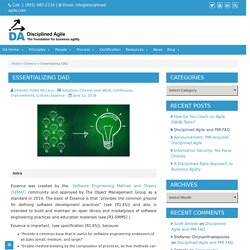
The basic of Essence is that “provides the common ground for defining software development practices” (see [R1-ES]) and also is intended to build and maintain an open library and marketplace of software engineering practices and education materials (see [R3-SMMS] ). Essence is important, (see specification [R1-ES]), because: “Provide a common base that is useful for software engineering endeavors of all sizes (small, medium, and large)” “Enable method building by the composition of practices, so that methods can be quickly assembled by a project team to match their needs, experiences, and aspirations. Disciplined Agile 2.X. The Reuse Engineering process blade addresses the purposeful creation (or rescue), management, support, and governance of reusable assets.
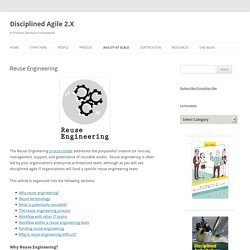
Reuse engineering is often led by your organization’s enterprise architecture team, although as you will see disciplined agile IT organizations will fund a specific reuse engineering team. This article is organized into the following sections: Why Reuse Engineering? The vast majority of developers, agile or otherwise, take an ad-hoc approach to reuse. Although this is a good start, we have the opportunity to do much better. Quicker time to market. Reuse Terminology We use the following definitions for common reuse terminology: Asset. How to Choose an Agile Release Cadence. One of the things that a delivery team needs to do, often in collaboration with product management, is choose the release cadence of their product.

This is an important aspect of, you guessed it, release planning. Your release cadence defines how often you release your solution both internally and externally into production (or the marketplace). The issue is how to determine how often the product should be released into production. In this blog we explore: Time Tracking and Agile Software Development. One of the key aspects of a disciplined agile approach is to be enterprise aware.
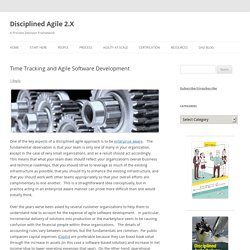
The fundamental observation is that your team is only one of many in your organization, except in the case of very small organizations, and as a result should act accordingly. This means that what your team does should reflect your organization’s overall business and technical roadmaps, that you should strive to leverage as much of the existing infrastructure as possible, that you should try to enhance the existing infrastructure, and that you should work with other teams appropriately so that your overall efforts are complimentary to one another.
This is a straightforward idea conceptually, but in practice acting in an enterprise aware manner can prove more difficult than one would initially think. Over the years we’ve been asked by several customer organizations to help them to understand how to account for the expense of agile software development. So, I thought I’d run a simple test. In Summary. Disciplined Agile Consortium - Slide Decks. Disciplined Agile Consortium - Posters. Disciplined Agile Data Warehousing. This article overviews a Disciplined Agile approach to data warehouse (DW) solution development.

The focus of this article is on the process itself, as opposed to specific architecture and design techniques (for those I highly suggest Data Vault 2). Furthermore, this topic is clearly worthy of a book containing detailed descriptions of the techniques and artifacts described below (however, I have included numerous links to such details if you're willing to explore further on your own). This article addresses: 1. Kaveh Kalantar's Blog: DAD Inception Phase Workshop Agenda. Disciplined Agile Delivery (DAD) realised the reality of the projects and introduced back phases to Agile community.
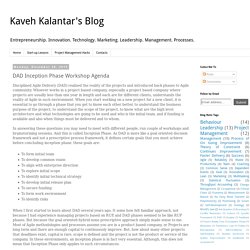
Whoever works in a project based company, especially a project based company where projects are usually less than one year in length and each are for different clients, understands the reality of Agile in such environment. When you start working on a new project for a new client, it is essential to go through a phase that you get to know each other better, to understand the business purpose of the project, to understand the scope of the project, to know what are the high level architecture and what technologies are going to be used and who is the initial team, and if funding is available and also when things must be delivered and to whom. In answering these questions you may need to meet with different people, run couple of workshops and brainstorming sessions.
And this is called Inception Phase. Inception Phase Workshop Agenda. Agile/Evolutionary Data Modeling: From Domain Modeling to Physical Modeling. I'd like to start with a few simple definitions: Data modeling is the act of exploring data-oriented structures.
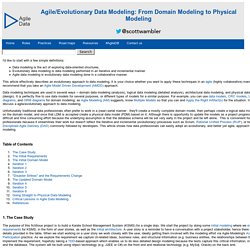
Evolutionary data modeling is data modeling performed in an iterative and incremental manner. Disciplined Agile Delivery. The Disciplined Agile Delivery (DAD) framework is orthogonal to tools.

What we mean by that is the principles, practices, and techniques captured by the framework are independent of specific tools. Obviously, some practices such as continuous integration (CI), test-driven development (TDD), and continuous delivery (CD) clearly need tooling support. But for each of those practices there are many, many tools you could possibly adopt. The DAD framework suggests that you adopt tools in these cases, but doesn’t specify exactly which tool to adopt nor will it ever. Tooling choices should be made by your team, often influenced by organizational guidance, not by the DAD framework. Crushed by Technical Debt. Crushed By Technical Debt? On Wednesday October 21, 2015 the Disciplined Agile Consortium hosted a webcast entitled “Crushed by Technical Debt?”
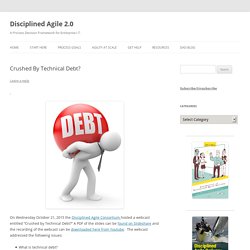
A PDF of the slides can be found on Slideshare and the recording of the webcast can be downloaded here from Youtube. The webcast addressed the following issues: What is technical debt? How can we avoid technical debt? How do we identify technical debt? As you can imagine we ran out of time to answer all of the questions that we received during the presentation.
Additional topics: Question: What’s your opinion regarding separating tech debt into separate stories? Governance Disciplined Agile Teams. The Process of Database Refactoring: Strategies for Improving Database Quality. You learned in A Vision for the Agile Data Method that agile methodologies such as eXtreme Programming (XP) (Beck 2000) and DSDM (Stapleton 2003) take an iterative and incremental approach to software development.
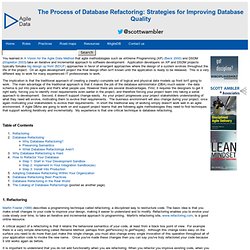
Application developers on XP and DSDM projects typically forsake big design up front (BDUF) approaches in favor of emergent approaches where the design of a system evolves throughout the life of the project. On an agile development project the final design often isn't known until the application is ready to be released. This is a very different way to work for many experienced IT professionals to work. The implication is that the traditional approach of creating a (nearly) complete set of logical and physical data models up front isn't going to work. The main advantage of the traditional approach is that it makes the job of the database administrator (DBA) much easier - the data schema is put into place early and that's what people use. Table of Contents 1. 2. 3. Coupling. 4. Disciplined Agile Delivery. Many organizations start their agile journey by adopting Scrum because it describes a good strategy for leading agile software teams.
However, Scrum is only part of what is required to deliver sophisticated solutions to your stakeholders. Invariably teams need to look to other methods to fill in the process gaps that Scrum purposely ignores. When looking at other methods there is considerable overlap and conflicting terminology that can be confusing to practitioners as well as outside stakeholders. Worse yet people don’t always know where to look for advice or even know what issues they need to consider. To address these challenges the Disciplined Agile Delivery (DAD) process decision framework provides a more cohesive approach to agile solution delivery. There are clearly some interesting aspects to the DAD framework.
Disciplined Agile Consortium - Home. Disciplined Agile Delivery. Look Ahead Modeling (Model A Bit Ahead): An Agile Best Practice. Sometimes you find yourself in a situation where you can't easily model storm a requirement or design issue for a few minutes on a just-in-time (JIT) basis. Perhaps your stakeholder(s) aren't available 100% of the time, perhaps they don't fully understand a difficult issue, or perhaps you are so tight for time that you don't mind potentially wasting money on over modeling for the sake of shaving a week or two off your schedule. In these situations you may decide to have someone model a bit ahead of the developers on your team, gathering information, exploring requirements, and thinking through the detailed design before you actually implement the software.
This modeling is done in parallel to the development effort, often a few days or weeks before the information is actually needed. Motivation There are several reasons why you might want to perform look ahead modeling: Stakeholders are only available at certain times. Figure 1. Solution Figure 2. Consequences Acknowledgements. Intro to DAC 2 0 for instructors.